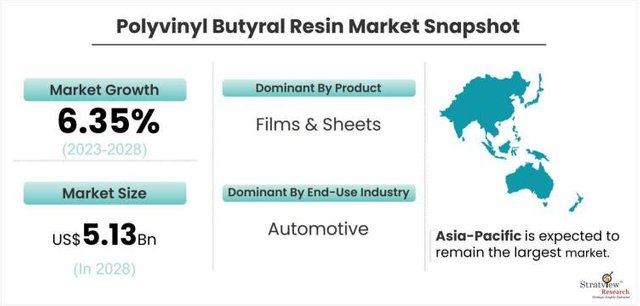Exploring the Polyvinyl Butyral Resin Market: Trends, Dynamics, and Future Outlook
The polyvinyl butyral resin market is experiencing significant growth, driven by its extensive use in applications that demand high adhesion, clarity, flexibility, and impact resistance. polyvinyl butyral resins, primarily utilized in laminated safety glass, automotive, and architectural applications, are increasingly popular as industries recognize their beneficial properties, particularly in enhancing safety and durability. This article explores key trends, market dynamics, and the future outlook of the polyvinyl butyral resin market.
According to Stratview Research, the polyvinyl butyral resin market was estimated at USD 3.53 billion in 2022 and is likely to grow at a CAGR of 6.35% during 2023-2028 to reach USD 5.13 billion in 2028.

Key Market Trends
One of the dominant trends in the polyvinyl butyral resin market is the rising demand from the automotive and construction industries. The automotive sector, in particular, has shown a strong preference for polyvinyl butyral laminated glass to improve vehicle safety, as these materials prevent shattering during collisions. In the construction industry, architectural glass applications benefit from polyvinyl butyral sound insulation and UV protection, contributing to the aesthetic and functional appeal of buildings. Additionally, growing environmental awareness is spurring the adoption of sustainable and recyclable polyvinyl butyral products, aligning with global initiatives for greener materials.
Market Dynamics
The growth of the polyvinyl butyral resin market is influenced by multiple dynamics. On one hand, increasing urbanization and infrastructure development worldwide are driving demand, as more high-rise buildings and modern architectural structures incorporate laminated glass for safety and energy efficiency. Furthermore, advancements in automotive safety standards have bolstered demand, as polyvinyl butyral laminated glass is increasingly used in windshields and other vehicle components.
However, the market faces certain challenges. The production of polyvinyl butyral resin involves complex manufacturing processes, leading to high costs that can limit adoption in cost-sensitive markets. Additionally, regulatory challenges related to volatile organic compounds (VOCs) in resin production have led manufacturers to seek innovations in greener and low-VOC alternatives, thereby pushing up R&D costs.
Future Outlook
The future of the polyvinyl butyral resin market looks promising, with forecasts indicating continued growth. Technological advancements, particularly in recycling polyvinyl butyral from decommissioned windshields and glass panels, are expected to enhance sustainability and reduce production costs. Geographic regions such as Asia-Pacific are anticipated to see significant growth, fueled by rapid industrialization, increased automotive production, and government investments in infrastructure.
In summary, the polyvinyl butyral resin market is set for robust expansion, underpinned by rising demand across key sectors, growing sustainability efforts, and advancements in manufacturing technology. As industries continue to prioritize safety and environmental standards, polyvinyl butyral resins are likely to play a pivotal role in shaping the future of materials in both automotive and architectural applications.